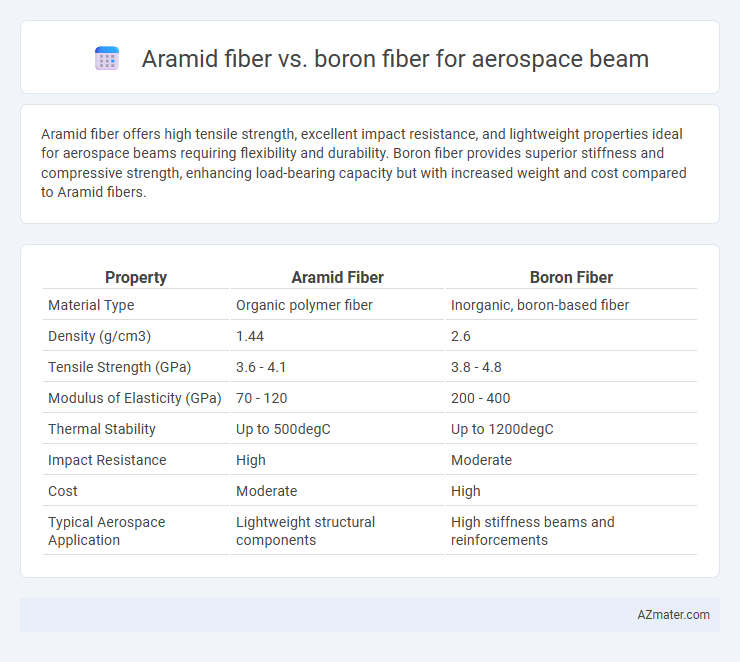Aramid fiber offers high tensile strength, excellent impact resistance, and lightweight properties ideal for aerospace beams requiring flexibility and durability. Boron fiber provides superior stiffness and compressive strength, enhancing load-bearing capacity but with increased weight and cost compared to Aramid fibers.
Table of Comparison
| Property | Aramid Fiber | Boron Fiber |
|---|---|---|
| Material Type | Organic polymer fiber | Inorganic, boron-based fiber |
| Density (g/cm3) | 1.44 | 2.6 |
| Tensile Strength (GPa) | 3.6 - 4.1 | 3.8 - 4.8 |
| Modulus of Elasticity (GPa) | 70 - 120 | 200 - 400 |
| Thermal Stability | Up to 500degC | Up to 1200degC |
| Impact Resistance | High | Moderate |
| Cost | Moderate | High |
| Typical Aerospace Application | Lightweight structural components | High stiffness beams and reinforcements |
Introduction to Advanced Fiber Materials in Aerospace
Advanced fiber materials such as Aramid fiber and Boron fiber play critical roles in aerospace beam applications due to their exceptional strength-to-weight ratios and thermal stability. Aramid fibers, known for their impact resistance and toughness, are widely used in structural reinforcements and vibration damping, while Boron fibers offer superior stiffness and high modulus, enhancing load-bearing capacity in aerospace beams. The integration of these fibers optimizes performance by balancing weight reduction with enhanced mechanical properties, meeting stringent aerospace standards for durability and efficiency.
Overview of Aramid Fiber Properties
Aramid fiber exhibits exceptional tensile strength, low density, and superior impact resistance, making it ideal for aerospace beam applications where lightweight durability is critical. Its high modulus of elasticity provides excellent stiffness while maintaining flexibility, enhancing structural performance under dynamic loads. Compared to boron fiber, aramid fiber offers enhanced toughness and resistance to fatigue, contributing to longer service life in aerospace components.
Key Characteristics of Boron Fiber
Boron fiber exhibits exceptional stiffness with a tensile modulus of around 400-450 GPa, surpassing aramid fiber's 70-125 GPa, making it ideal for aerospace beams requiring high rigidity. Its high tensile strength, typically 2.8-3.5 GPa, and excellent compressive properties enhance load-bearing capacity in structural aerospace components. Despite higher cost and brittleness compared to aramid fiber, boron fiber's superior thermal stability and low thermal expansion coefficient contribute to dimensional stability under extreme aerospace operating conditions.
Strength and Stiffness Comparison
Aramid fiber exhibits high tensile strength and excellent impact resistance, making it suitable for aerospace beams requiring lightweight durability. Boron fiber surpasses aramid in stiffness, offering a higher modulus of elasticity, which is essential for structural components demanding minimal deformation under load. In aerospace applications, the choice hinges on prioritizing either aramid's superior toughness or boron's enhanced rigidity for optimized beam performance.
Weight and Density Considerations
Aramid fiber exhibits a low density of approximately 1.44 g/cm3, offering significant weight savings crucial for aerospace beam applications where minimizing mass enhances fuel efficiency and payload capacity. Boron fiber, despite its higher density around 2.6 g/cm3, delivers superior stiffness and strength, which can justify its use when structural rigidity is paramount. The trade-off between Aramid's lightweight advantage and Boron's mechanical performance necessitates careful evaluation based on the specific aerospace beam design requirements.
Thermal and Chemical Resistance
Aramid fiber exhibits excellent thermal stability with a decomposition temperature around 500degC, making it suitable for aerospace beams exposed to moderate heat, while its chemical resistance resists most solvents and oils without degradation. Boron fiber surpasses aramid in thermal resistance, maintaining structural integrity up to 800degC and providing superior stiffness-to-weight ratios essential for high-performance aerospace applications. Chemically, boron fiber resists corrosion and oxidation better than aramid, especially in harsh aerospace environments involving exposure to acids and oxidizing agents.
Fatigue and Impact Performance
Aramid fiber exhibits exceptional fatigue resistance and impact absorption, making it highly suitable for aerospace beams requiring durability under cyclic loading and sudden shocks. Boron fiber offers superior stiffness and compressive strength but generally demonstrates lower impact resistance and fatigue life compared to aramid composites. Optimizing aerospace beam design involves balancing aramid's energy dissipation capabilities with boron fiber's structural rigidity for enhanced long-term performance.
Cost and Manufacturing Challenges
Aramid fiber offers significant cost advantages over Boron fiber, making it a preferred choice for aerospace beam applications where budget constraints are critical. Manufacturing challenges with Boron fiber include complex handling and high-temperature processing requirements, which increase production time and difficulty. Aramid fiber's easier fabrication and lower processing costs contribute to its widespread use despite Boron fiber's superior stiffness and strength.
Typical Aerospace Beam Applications
Aramid fiber is widely used in aerospace beams for applications requiring exceptional impact resistance, high tensile strength, and lightweight properties, such as helicopter rotor blades and fuselage reinforcements. Boron fiber is preferred in aerospace beams demanding superior stiffness and compressive strength, often found in missile structures and aircraft wing spars where enhanced rigidity is critical. Both fibers contribute to advanced composite materials that optimize performance under dynamic loads and extreme environmental conditions.
Conclusion: Selecting the Optimal Fiber for Aerospace Beams
Aramid fiber offers superior impact resistance and low weight, making it ideal for aerospace beams requiring high toughness and flexibility. Boron fiber provides exceptional stiffness and compressive strength, crucial for components demanding rigidity and load-bearing capacity. Selecting the optimal fiber depends on balancing performance needs, with Aramid favored for impact-prone applications and Boron chosen for structural stiffness in aerospace beam design.

Infographic: Aramid fiber vs Boron fiber for Aerospace beam
 azmater.com
azmater.com